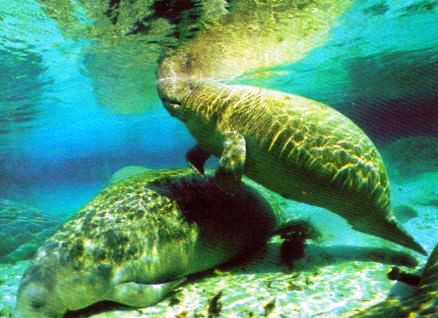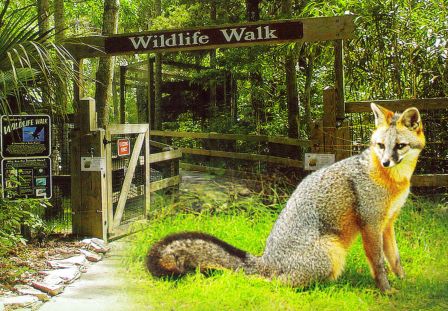Discover Florida Nature
It's time to explore the natural Florida


|
|
|
|
|
 Homosassa
which translates to "where the wild peppers grow", was the former
residence of Calusa and
Seminole Indian tribes. Now owned by the state of Florida Homosassa
Springs Wildlife Park is a trip back in time to rediscover Florida
nature at its best. Homosassa Springs Wildlife Park offers the
opportunity to encounter native Florida wildlife in a natural setting. Homosassa
which translates to "where the wild peppers grow", was the former
residence of Calusa and
Seminole Indian tribes. Now owned by the state of Florida Homosassa
Springs Wildlife Park is a trip back in time to rediscover Florida
nature at its best. Homosassa Springs Wildlife Park offers the
opportunity to encounter native Florida wildlife in a natural setting. A 45 foot deep natural spring is the centerpiece of this more than 210 acre large park, located on US 19 in Homosassa Springs, Florida. The springs are the headwaters of the beautiful Homosassa River that flows nine miles west into the Gulf of Mexico. Saltwater and freshwater fish are attracted to these natural springs with their constant, year-round temperature of 72 degrees F. A floating underwater observatory inside the springs allows the visitor to view fish and manatee at close range. Huge springs, from which millions of gallons of clear water bubble every hour, are the headwaters of the beautiful Homosassa River. A floating observation platform (the Fish Bowl) inside these springs allows the visitor to see a large variety of fresh and saltwater fish, manatees and turtles. Quite frequently a curious manatee will swim up to the window and look at the visitors inside the underground observatory. Homosassa Springs Wildlife State Park serves as a rehabilitation and refuge center for injured West Indian manatees. Many other manatees prefer to spend the winter months around these constant temperature springs of the Homosassa River. All these creatures can travel unrestricted between the headwaters and the Gulf of Mexico. Homosassa Springs Wildlife Park is one of the few places in Florida to see a red wolf. Once living throughout the Southeastern United States from Texas to Florida, the Red Wolf may have ranged as far north as New York State. Wild populations of these animals were eliminated by the 1960's, owing to predator control programs and habitat loss, and the species was declared endangered in 1973. Red wolves are now being sustained by captive populations and efforts to reintroduce them to their former range currently are being made in North Carolina. Almost hunted out of existence, 14 of the last wild Red Wolves were trapped by the U.S. Fish and Wildlife Service as the basis for a captive breeding program. As of 2007, about 170 animals now live in captivity in 38 facilities across the U.S. Another 130 have been released into the wild.  Black
bears have also found a safe home in Homosassa Springs State Park. Once estimated at 12,000 animals throughout Florida, Alabama and Southern
Georgia, there are less than 1,500 bears left today. No human has ever been killed by a Black bear in Florida. An average male weighs
350 pounds, while a female averages about 150 pounds. A black bearīs diet is
about 80% vegetable matter. Such foods include berries, acorns, insects and
palmetto hearts. Both wetlands and upland forest habitats are home to the
Florida black bear. Black
bears have also found a safe home in Homosassa Springs State Park. Once estimated at 12,000 animals throughout Florida, Alabama and Southern
Georgia, there are less than 1,500 bears left today. No human has ever been killed by a Black bear in Florida. An average male weighs
350 pounds, while a female averages about 150 pounds. A black bearīs diet is
about 80% vegetable matter. Such foods include berries, acorns, insects and
palmetto hearts. Both wetlands and upland forest habitats are home to the
Florida black bear.The Park currently houses a Western cougar as well as a a newly arrived Florida panther. His name is Don Juan. There are only about 50 Florida panthers left in Florida. Panthers generally occupy upper dry land areas of the hardwood hammock, pine flatwoods, saw palmetto and cabbage palm thickets. They also inhabit wetland areas such as cypress forest, thicket swamps and freshwater marsh. Palmetto and drier scrub areas are often used for denning and day beds. Panthers prefer a secluded environment away from people and are rarely seen in agricultural areas and citrus groves. Most active at dusk and dawn, a panther can travel up to 20 miles a day, often moving in a zigzag pattern. They tend to hunt during the cooler hours of the day and rest in the hot afternoon hours. A special resident of Homosassa Springs State Park is Lucifer, the hippopotamus. Native to central Africa, these nocturnal mammals are commonly found at or in deep water rivers with marshes and reeds. The average length of a hippo is approximately 11 feet with a shoulder height of 4.5 to 5 feet. A male can weigh between 3,500 and 7,000 pounds while the female is much smaller, reaching approximately 3,000 pounds. They have a large broad mouth and short broad legs with four toes on each foot. A hippoīs eyes, ears and nose are all found on the top of the head so the animal can see, hear and breathe while remaining mostly submerged. Why, you may ask, is an African species found at a Florida park with all native wildlife? Well, Lu has lived here all his life. He was a big movie star when this was an exotic animal park. Local residents took a special liking to Lu and often visited him between his many movies. When the Park went to strictly native species, Lu was bound for a transfer. You can imagine the demand for a 6,000 pound hippopotamus is not particularly high. When the locals caught wind of the intended transfer they put up a fight to keep Lu here. Needless to say, their voices were heard, and Lu was granted honorary state citizenship. |
|
|
Homosassa Springs State Park Florida
Homosassa Springs Wildlife Park is one of the few places in Florida to see a red wolf, and to view West Indian manatees swimming freely in a natural environment. Located on the West coast of Florida, a 45 foot deep natural spring is the centerpiece of this more than 210 acre large park, located on US 19 in Homosassa Springs, Florida.
Saltwater and freshwater fish are attracted to these natural springs with their constant, year-round temperature of 72 degrees F. A floating underwater observatory inside the springs allows the visitor to view fish and manatee at close range. Huge springs, from which millions of gallons of clear water bubble every hour, are the headwaters of the beautiful Homosassa River. A floating observation platform (the Fish Bowl) inside these springs allows the visitor to see a large variety of fresh and saltwater fish, manatees and turtles. Quite frequently a curious manatee will swim up to the window and look at the visitors inside the underground observatory. Homosassa Springs Wildlife State Park serves as a rehabilitation and refuge center for injured West Indian manatees. Many other manatees prefer to spend the winter months around these constant temperature springs of the Homosassa River. All these creatures can travel unrestricted between the headwaters and the Gulf of Mexico. Other Florida animals you can view at Homosassa Springs State Park include bears, key deer, a wide variety of birds, alligators, and even a hippo.
Written by: Floridian Nature
Homosassa Springs State Park
Date published: 10/22/2013
4 / 5 stars
|
|